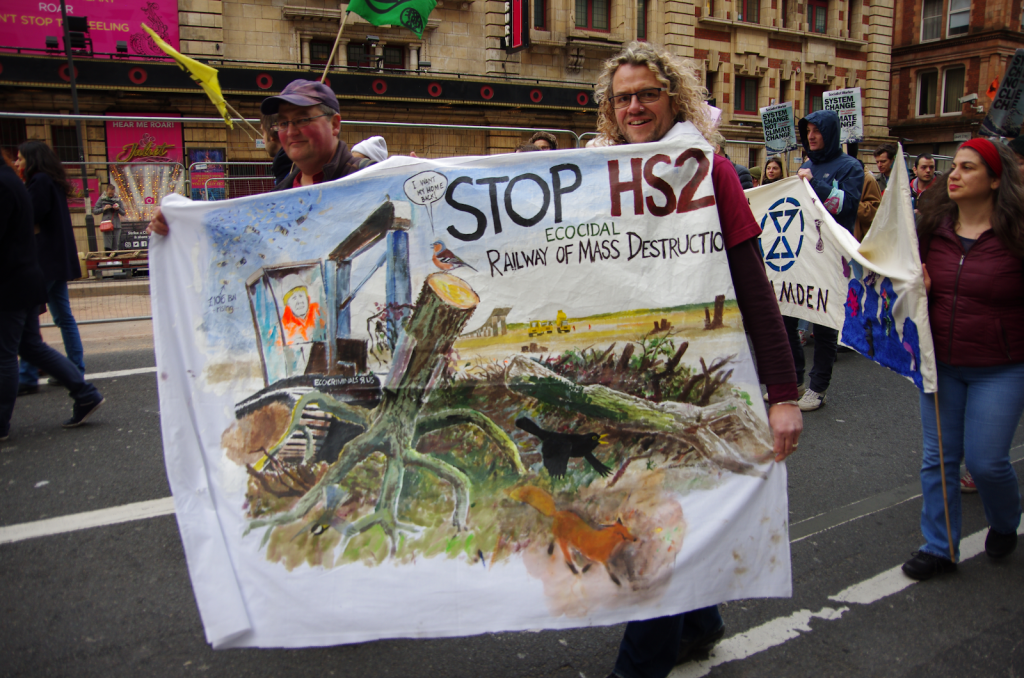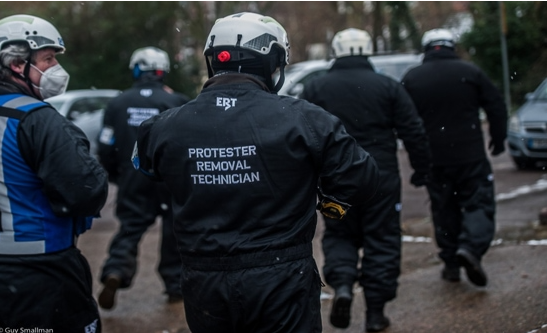Perhaps the biggest lie peddled by the global “development” mafia is that they have our consent to destroy nature and community.
In truth nearly every step they take in their crazed quest for profit and control meets with opposition.
People don’t want to see green fields near where they live turned into supermarkets or industrial estates.
People don’t want to see a motorway tear through the woodland where they walk their dog every morning.
People don’t want to see the countryside around them scarred and polluted by the toxic infrastructure of fracking.
Because the financial interests behind these projects have all the power that money can buy, they usually manage to get official permission to go ahead despite public hostility.
But what happens when people refuse to back down, when they fight to protect the land from the mafia’s machineries?
It is at this point that the money-nexus has to deploy its most important weapon: the power and violence of the state.
Some useful analysis of how it does this can be found in a new academic book called Enforcing Ecocide: Power, Policing and Planetary Militarization, edited by Alexander Dunlap and Andrea Brock.
One chapter looks at the High Speed 2 (HS2) rail scheme in England, described as “the largest and most expensive post-war development in the UK” (1) and currently Europe’s largest infrastructure project.
Write authors Andrea Brock and Jan Goodey: “Framed by the UK government as environmentally beneficial and contributing to economic growth, it is strongly resisted by campaigners and residents along its proposed route.
“They criticise the project for negatively affecting 108 ancient woodlands, destroying irreplaceable nature reserves, ecosystems, chalk aquifers, and waterways, as well as for the lack of economic benefits, and the huge costs for taxpayers”. (2)
The spiralling cost has seen parts of the original plan abandoned, but this nature-wrecking project will still funnel billions and billions of pounds from the public purse into private pockets – which is, of course, the whole point of development schemes.
The authors explain: “Resistance along the route takes various shapes and forms — from legal challenges, lobbying, demonstrations, to direct action, including the continuous occupation and setup of protest camps along the proposed HS2 pathway to disrupt and slow down its development”. (3)

They examine in detail the policing and corporate-state collusion used against this resistance, analysing the techniques and technologies of control as well as the violence of repression.
And they say this kind of public-private political policing in fact uses “counterinsurgency techniques” (4) first drawn up to impose and maintain the British empire – itself a global-scale development bonanza for the financial vermin who have long lurked in the sewers of the City of London.
“It’s a style of warfare that makes use of intelligence networks, psychological operations, media manipulation, and security provision, including social development that seeks to maintain governmental legitimacy”. (5)
The authors look, for instance, at the activities of the High Court Enforcement (HCE) Group which, despite its official-sounding name, is in fact a private company subcontracted by HS2 Ltd.
It combats protest by employing people sometimes described as “violence workers”, that is to say former cops, bouncers or security guards.
Brock and Goodey note: “The company currently faces legal proceedings following the injuries of a number of protesters in a spate of separate incidents”. (6)
They also describe the way that corporate injunctions (originally introduced in 1999, supposedly to combat “stalking”) are used not only to deter protest but also to stop people monitoring the developers’ illegal activities, such as the removal of nesting birds and badgers from ancient woodland. (7)
Data collection and surveillance also form part of the public-private repression.
Write the authors: “In 2016 it was uncovered in the Sunday Express that an internal HS2 Ltd. document stated that the company was looking to gather information on the sexual orientation, sex lives, mental health, criminal records, and political views of protesters, complainants and litigants including those seeking compensation or objecting to the project, as part of the company’s Privacy Notice.
“The information could be volunteered freely but it could also be aggregated from doctors, the taxman, lawyers, the courts, security companies and credit agencies; third parties including healthcare, social and welfare advisers or practitioners, HM Revenue and Customs, law enforcement and security agencies and bodies, and relatives, guardians or other persons associated with the individual. This illustrates the involvement of different parts of the (welfare) state in policing dissent”. (8)
They also quote people who have been shocked by the heavy policing.
Said one resident: “This is the first time in my life that I’ve felt I’m in a police state. I was scared, intimidated. At one point it was suggested I couldn’t leave the area, or I may be arrested. I was struggling to believe this was the UK”. (9)
This policing includes harassment, verbal abuse, intimidation and, of course, physical coercion. (10)
Cops have broken protesters’ fingers with their boots; a bailiff left someone unable to move after he stamped on their head; other campaigners have had their noses broken or lost consciousness after being choke-held high up in tree canopies. (11)
One supporter of the protests describes being attacked by the National Eviction Team (NET), owned by the aforementioned HCE Group, while trying to leave a site.
“Eventually someone opened the car, punched me in the face at least three times and broke my jaw… I’m still in shock. I’ve seen the NET hurt my friends before, but I never expected to get attacked outside of a protest”. (12)
The victim needed hospital treatment after this brutal state-sanctioned assault.

The authors comment: “Occasionally, incidents of violence – especially when recorded by campaigners – make it into the media, with accusations against security forces and bailiffs for severely injuring activists, including causing head injuries and choking campaigners.
“Yet, they rarely lead to prosecutions or convictions, and usually remain without consequences”. (13)
The authors say that their evidence “illustrates that the view of the police as protector of public safety was only ever a liberal myth”. (14)
They add: “Rather than protecting the right to protest, police collaborate with corporate security services to further limit this right and to facilitate HS2 development, while ignoring assaults on protesters and wildlife crimes”. (15)
We could go further and say that the state for which the police supposedly work is itself nothing but a tool for the global financial mafia.
This mafia uses the state to launch endless phases of development – of its own wealth! – and it also uses the state to violently crush anyone who dares get in the way of its high-speed/high-greed destruction of our world and our lives.

- Andrea Brock, Jan Goodey, ‘Policing the High Speed 2 (HS2) Train Line: Repression and Collusion Along Europe’s Biggest Infrastructure Project’, Alexander Dunlap, Andrea Brock (eds), Enforcing Ecocide: Power, Policing and Planetary Militarization (Cham, Switzerland: Palgrave Macmillan, 2022), p. 228. All subsequent page references are for this work.
- p. 228.
- p. 228.
- p. 229.
- p. 231.
- p. 243.
- p. 248.
- p. 250.
- pp. 247-48.
- p. 251.
- p. 253.
- p. 254.
- p. 251.
- p. 245.
- p. 245.



But but… Greta LOVES trains!